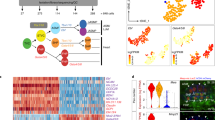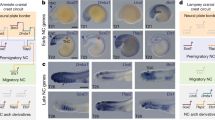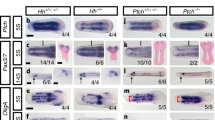Abstract
The evolution of vertebrates from an ancestral chordate was accompanied by the acquisition of a predatory lifestyle closely associated to the origin of a novel anterior structure, the highly specialized head. While the vertebrate head mesoderm is unsegmented, the paraxial mesoderm of the earliest divergent chordate clade, the cephalochordates (amphioxus), is fully segmented in somites. We have previously shown that fibroblast growth factor signalling controls the formation of the most anterior somites in amphioxus; therefore, unravelling the fibroblast growth factor signalling downstream effectors is of crucial importance to shed light on the evolutionary origin of vertebrate head muscles. By using a comparative RNA sequencing approach and genetic functional analyses, we show that several transcription factors, such as Six1/2, Pax3/7 and Zic, act in combination to ensure the formation of three different somite populations. Interestingly, these proteins are orthologous to key regulators of trunk, and not head, muscle formation in vertebrates. Contrary to prevailing thinking, our results suggest that the vertebrate head mesoderm is of visceral and not paraxial origin and support a multistep evolutionary scenario for the appearance of the unsegmented mesoderm of the vertebrates new ‘head’.
This is a preview of subscription content, access via your institution
Access options
Access Nature and 54 other Nature Portfolio journals
Get Nature+, our best-value online-access subscription
$29.99 / 30 days
cancel any time
Subscribe to this journal
Receive 12 digital issues and online access to articles
$119.00 per year
only $9.92 per issue
Buy this article
- Purchase on Springer Link
- Instant access to full article PDF
Prices may be subject to local taxes which are calculated during checkout




Similar content being viewed by others
Data availability
Sequences for probe synthesis are available in Genbank (see Supplementary Table 1). RNA-seq data are available under Gene Expression Omnibus (GEO) accession no. GSE122245. The ATAC-seq data sets presented in this study were previously used in refs. 69,70 and are available under GEO accession no. GSE68737.
References
von Goethe, J. W. in Zur Naturwissenschaft überhaupt, besonders zur Morphologie: Erfahrung, Betrachtung, Folgerung, durch Lebensereignisse verbunden (Cotta, 1820).
Goodrich,E. S. Studies on the Structure & Development of Vertebrates. (Chicago University Press, 1986).
Owen,R. The Principal Forms of the Skeleton and of the Teeth. (Blanchard & Lea, 1854).
Kuratani, S., Horigome, N. & Hirano, S. Developmental morphology of the head mesoderm and reevaluation of segmental theories of the vertebrate head: evidence from embryos of an agnathan vertebrate, Lampetra japonica. Dev. Biol. 210, 381–400 (1999).
Freund, R., Dörfler, D., Popp, W. & Wachtler, F. The metameric pattern of the head mesoderm—does it exist? Anat. Embryol. (Berl.) 193, 73–80 (1996).
Bothe, I. & Dietrich, S. The molecular setup of the avian head mesoderm and its implication for craniofacial myogenesis. Dev. Dyn. 235, 2845–2860 (2006).
Kuratani, S. & Adachi, N. What are head cavities? A history of studies on vertebrate head segmentation. Zool. Sci. 33, 213–228 (2016).
Dequéant, M. L. & Pourquié, O. Segmental patterning of the vertebrate embryonic axis. Nat. Rev. Genet. 9, 370–382 (2008).
Hubaud, A. & Pourquié, O. Signalling dynamics in vertebrate segmentation. Nat. Rev. Mol. Cell Biol. 15, 709–721 (2014).
Yusuf, F. & Brand-Saberi, B. The eventful somite: patterning, fate determination and cell division in the somite. Anat. Embryol. (Berl.) 211, 21–30 (2006).
Tzahor, E. Heart and craniofacial muscle development: a new developmental theme of distinct myogenic fields. Dev. Biol. 327, 273–279 (2009).
Sambasivan, R., Kuratani, S. & Tajbakhsh, S. An eye on the head: the development and evolution of craniofacial muscles. Development 138, 2401–2415 (2011).
Delsuc, F., Brinkmann, H., Chourrout, D. & Philippe, H. Tunicates and not cephalochordates are the closest living relatives of vertebrates. Nature 439, 965–968 (2006).
Bertrand, S. & Escriva, H. Evolutionary crossroads in developmental biology: amphioxus. Development 138, 4819–4830 (2011).
Holland, L. Z., Kene, M., Williams, N. A. & Holland, N. D. Sequence and embryonic expression of the amphioxus engrailed gene (AmphiEn): the metameric pattern of transcription resembles that of its segment-polarity homolog in Drosophila. Development 124, 1723–1732 (1997).
Bertrand, S. et al. Amphioxus FGF signaling predicts the acquisition of vertebrate morphological traits. Proc. Natl Acad. Sci. USA 108, 9160–9165 (2011).
Schubert, M., Holland, L. Z., Stokes, M. D. & Holland, N. D. Three amphioxus Wnt genes (AmphiWnt3, AmphiWnt5, and AmphiWnt6) associated with the tail bud: the evolution of somitogenesis in chordates. Dev. Biol. 240, 262–273 (2001).
Bertrand, S. et al. Evolution of the role of RA and FGF signals in the control of somitogenesis in chordates. PLoS ONE 10, e0136587 (2015).
Beaster-Jones, L. et al. Expression of somite segmentation genes in amphioxus: a clock without a wavefront? Dev. Genes Evol. 218, 599–611 (2008).
Holland, P. W. H. Embryonic development of heads, skeletons and amphioxus: Edwin S. Goodrich revisited. Int. J. Dev. Biol. 44, 29–34 (2000).
Gans, C. & Northcutt, R. G. Neural crest and the origin of vertebrates: a new head. Science 220, 268–273 (1983).
Holland, L. Z., Holland, N. D. & Gilland, E. Amphioxus and the evolution of head segmentation. Integr. Comp. Biol. 48, 630–646 (2008).
Kuratani, S. Is the vertebrate head segmented? Evolutionary and developmental considerations. Integr. Comp. Biol. 48, 647–657 (2008).
Kuratani, S. & Schilling, T. Head segmentation in vertebrates. Integr. Comp. Biol. 48, 604–610 (2008).
Northcutt, R. G. Historical hypotheses regarding segmentation of the vertebrate head. Integr. Comp. Biol. 48, 611–619 (2008).
Onai, T., Adachi, N. & Kuratani, S. Metamerism in cephalochordates and the problem of the vertebrate head. Int. J. Dev. Biol. 61, 621–632 (2017).
Raible, F. & Brand, M. Tight transcriptional control of the ETS domain factors Erm and Pea3 by Fgf signaling during early zebrafish development. Mech. Dev. 107, 105–117 (2001).
Roehl, H. & Nüsslein-Volhard, C. Zebrafish pea3 and erm are general targets of FGF8 signaling. Curr. Biol. 11, 503–507 (2001).
Buckingham, M. Gene regulatory networks and cell lineages that underlie the formation of skeletal muscle. Proc. Natl Acad. Sci. USA 114, 5830–5837 (2017).
Sadowski, I., Ma, J., Triezenberg, S. & Ptashne, M. GAL4-VP16 is an unusually potent transcriptional activator. Nature 335, 563–564 (1988).
Jaynes, J. B. & O’Farrell, P. H. Active repression of transcription by the engrailed homeodomain protein. EMBO J. 10, 1427–1433 (1991).
Khan, A. et al. JASPAR 2018: update of the open-access database of transcription factor binding profiles and its web framework. Nucleic Acids Res. 46, D1284 (2018).
Feng, J., Li, G., Liu, X., Wang, J. & Wang, Y. Q. Functional analysis of the promoter region of amphioxus β-actin gene: a useful tool for driving gene expression in vivo. Mol. Biol. Rep. 41, 6817–6826 (2014).
Pais-de-Azevedo, T., Magno, R., Duarte, I. & Palmeirim, I. Recent advances in understanding vertebrate segmentation. F1000Res. 7, 97 (2018).
Onai, T., Aramaki, T., Inomata, H., Hirai, T. & Kuratani, S. On the origin of vertebrate somites. Zoological Lett. 1, 33 (2015).
Shih, H. P., Gross, M. K. & Kioussi, C. Expression pattern of the homeodomain transcription factor Pitx2 during muscle development. Gene Expr. Patterns 7, 441–451 (2007).
Dastjerdi, A. et al. Tbx1 regulation of myogenic differentiation in the limb and cranial mesoderm. Dev. Dyn. 236, 353–363 (2007).
Nogueira, J. M. et al. The emergence of Pax7-expressing muscle stem cells during vertebrate head muscle development. Front. Aging Neurosci. 7, 62 (2015).
Guo, C. et al. A Tbx1-Six1/Eya1-Fgf8 genetic pathway controls mammalian cardiovascular and craniofacial morphogenesis. J. Clin. Invest. 121, 1585–1595 (2011).
Lin, C. Y. et al. The transcription factor Six1a plays an essential role in the craniofacial myogenesis of zebrafish. Dev. Biol. 331, 152–166 (2009).
Boorman, C. J. & Shimeld, S. M. Pitx homeobox genes in Ciona and amphioxus show left–right asymmetry is a conserved chordate character and define the ascidian adenohypophysis. Evol. Dev. 4, 354–365 (2002).
Yasui, K., Zhang, S., Uemura, M. & Saiga, H. Left–right asymmetric expression of BbPtx, a Ptx-related gene, in a lancelet species and the developmental left-sidedness in deuterostomes. Development 127, 187–195 (2000).
Li, G. et al. Cerberus–Nodal–Lefty–Pitx signaling cascade controls left–right asymmetry in amphioxus. Proc. Natl Acad. Sci. USA 114, 3684–3689 (2017).
Mahadevan, N. R., Horton, A. C. & Gibson-Brown, J. J. Developmental expression of the amphioxus Tbx1/10 gene illuminates the evolution of vertebrate branchial arches and sclerotome. Dev. Genes Evol. 214, 559–566 (2004).
Koop, D. et al. Roles of retinoic acid and Tbx1/10 in pharyngeal segmentation: amphioxus and the ancestral chordate condition. Evodevo 5, 36 (2014).
Nandkishore, N., Vyas, B., Javali, A., Ghosh, S. & Sambasivan, R. Divergent early mesoderm specification underlies distinct head and trunk muscle programmes in vertebrates. Development 145, dev160945 (2018).
Onimaru, K., Shoguchi, E., Kuratani, S. & Tanaka, M. Development and evolution of the lateral plate mesoderm: comparative analysis of amphioxus and lamprey with implications for the acquisition of paired fins. Dev. Biol. 359, 124–136 (2011).
Holland, N. D. Formation of the initial kidney and mouth opening in larval amphioxus studied with serial blockface scanning electron microscopy (SBSEM). Evodevo 9, 16 (2018).
Meulemans, D. & Bronner-Fraser, M. Insights from amphioxus into the evolution of vertebrate cartilage. PLoS ONE 2, e787 (2007).
Mazet, F., Amemiya, C. T. & Shimeld, S. M. An ancient Fox gene cluster in bilaterian animals. Curr. Biol. 16, R314–R316 (2006).
Pascual-Anaya, J. et al. The evolutionary origins of chordate hematopoiesis and vertebrate endothelia. Dev. Biol. 375, 182–192 (2013).
Holland, N. D., Venkatesh, T. V., Holland, L. Z., Jacobs, D. K. & Bodmer, R. AmphiNk2-tin, an amphioxus homeobox gene expressed in myocardial progenitors: insights into evolution of the vertebrate heart. Dev. Biol. 255, 128–137 (2003).
Belgacem, M. R., Escande, M. L., Escriva, H. & Bertrand, S. Amphioxus Tbx6/16 and Tbx20 embryonic expression patterns reveal ancestral functions in chordates. Gene Expr. Patterns 11, 239–243 (2011).
Lescroart, F. et al. Clonal analysis reveals common lineage relationships between head muscles and second heart field derivatives in the mouse embryo. Development 137, 3269–3279 (2010).
Tirosh-Finkel, L., Elhanany, H., Rinon, A. & Tzahor, E. Mesoderm progenitor cells of common origin contribute to the head musculature and the cardiac outflow tract. Development 133, 1943–1953 (2006).
Stolfi, A. et al. Early chordate origins of the vertebrate second heart field. Science 329, 565–568 (2010).
Wang, W., Razy-Krajka, F., Siu, E., Ketcham, A. & Christiaen, L. NK4 antagonizes Tbx1/10 to promote cardiac versus pharyngeal muscle fate in the ascidian second heart field. PLoS Biol. 11, e1001725 (2013).
Diogo, R. et al. A new heart for a new head in vertebrate cardiopharyngeal evolution. Nature 520, 466–473 (2015).
Tanaka, M. Developmental mechanism of limb field specification along the anterior–posterior axis during vertebrate evolution. J. Dev. Biol. 4, E18 (2016).
Fuentes, M. et al. Insights into spawning behavior and development of the European amphioxus (Branchiostoma lanceolatum). J. Exp. Zool. B Mol. Dev. Evol. 308, 484–493 (2007).
Fuentes, M. et al. Preliminary observations on the spawning conditions of the European amphioxus (Branchiostoma lanceolatum) in captivity. J. Exp. Zool. B Mol. Dev. Evol. 302, 384–391 (2004).
Holland, L. Z. & Holland, N. D. Expression of AmphiHox-1 and AmphiPax-1 in amphioxus embryos treated with retinoic acid: insights into evolution and patterning of the chordate nerve cord and pharynx. Development 122, 1829–1838 (1996).
Oulion, S., Bertrand, S., Belgacem, M. R., Le Petillon, Y. & Escriva, H. Sequencing and analysis of the Mediterranean amphioxus (Branchiostoma lanceolatum) transcriptome. PLoS ONE 7, e36554 (2012).
Li, H. & Durbin, R. Fast and accurate long-read alignment with Burrows–Wheeler transform. Bioinformatics 26, 589–595 (2010).
Anders, S. & Huber, W. Differential expression analysis for sequence count data. Genome Biol. 11, R106 (2010).
Götz, S. et al. High-throughput functional annotation and data mining with the Blast2GO suite. Nucleic Acids Res. 36, 3420–3435 (2008).
Somorjai, I., Bertrand, S., Camasses, A., Haguenauer, A. & Escriva, H. Evidence for stasis and not genetic piracy in developmental expression patterns of Branchiostoma lanceolatum and Branchiostoma floridae, two amphioxus species that have evolved independently over the course of 200 Myr. Dev. Genes Evol. 218, 703–713 (2008).
Hirsinger, E.et al. Expression of fluorescent proteins in Branchiostoma lanceolatum by mRNA injection into unfertilized oocytes. J. Vis. Exp.52042 (2015).
Yu, J. K., Holland, N. D. & Holland, L. Z. Tissue-specific expression of FoxD reporter constructs in amphioxus embryos. Dev. Biol. 274, 452–461 (2004).
Acemel, R. D. et al. A single three-dimensional chromatin compartment in amphioxus indicates a stepwise evolution of vertebrate Hox bimodal regulation. Nat. Genet 48, 336–341 (2016).
Marlétaz, F. et al. Amphioxus functional genomics and the origins of vertebrate gene regulation. Nature 564, 64–70 (2018).
Buenrostro, J. D., Wu, B., Chang, H. Y. & Greenleaf, W. J. ATAC-seq: a method for assaying chromatin accessibility genome-wide. Curr. Protoc. Mol. Biol. 109, 21.29.1–21.29.9 (2015).
Acknowledgements
The laboratory of H.E. was supported by the Centre national de la recherche scientifique and Agence nationale de la recherche (ANR) grant no. ANR-16-CE12-0008-01; S.B. was supported by the Institut Universitaire de France. D.A. holds a fellowship from Conicyt Becas Chile. J-L.G-S. was supported by the Spanish government (grant no. BFU2016-74961-P), the European Research Council (ERC) under the European Union’s Horizon 2020 research and innovation programme (grant no. 740041) and the institutional grant Unidad de Excelencia María de Maeztu (no. MDM-2016-0687). I.M. was funded by an EMBO short-term fellowship (ASTF 377-2014) and by the Spanish Government with a Juan de la Cierva postdoctoral contract (JCI-2012-13495). H.E. and S.M. were supported by the ECOS-CONICYT C15S02 grant. We acknowledge the Mediterranean Amphioxus Genome Consortium for providing access to genomic and transcriptomic data before publication. We thank T. Takahashi for providing the Tol2 mRNA production plasmid. Confocal imaging was undertaken at the BIOPIC platform which belongs to the EMBRC-France infrastructure supported by ANR grant no. ANR-10-INBS-02.
Author information
Authors and Affiliations
Contributions
H.E. and S.B. conceptualized the study. H.E., S.B., J-L.G.-S. and S.M. devised the methodology. D.A., C.K., L.M., I.M., L.S., S.B. and H.E. carried out the investigations. C.K., J-L.G.-S. and S.M. managed the resources. D.A., S.B. and H.E. wrote the original manuscript draft. D.A., L.S., C.K., I.M., S.M., J-L.G.-S., H.E. and S.B. reviewed and edited the draft. H.E., S.B., J-L.G.-S. and S.M. supervised the study.
Corresponding authors
Ethics declarations
Competing interests
The authors declare no competing interests.
Additional information
Publisher’s note: Springer Nature remains neutral with regard to jurisdictional claims in published maps and institutional affiliations.
Supplementary information
Supplementary Information
Supplementary Figs. 1–6 and supplementary results
Supplementary Table 1
Gene information
Rights and permissions
About this article
Cite this article
Aldea, D., Subirana, L., Keime, C. et al. Genetic regulation of amphioxus somitogenesis informs the evolution of the vertebrate head mesoderm. Nat Ecol Evol 3, 1233–1240 (2019). https://doi.org/10.1038/s41559-019-0933-z
Received:
Accepted:
Published:
Issue Date:
DOI: https://doi.org/10.1038/s41559-019-0933-z
This article is cited by
-
The evolution of complex multicellularity in animals
Biology & Philosophy (2022)
-
Vertebrate cranial mesoderm: developmental trajectory and evolutionary origin
Cellular and Molecular Life Sciences (2020)



